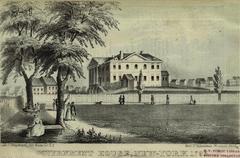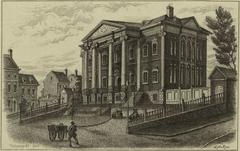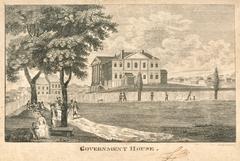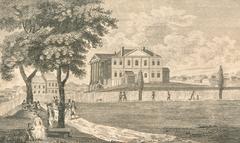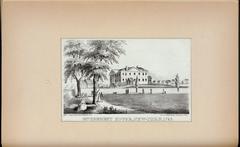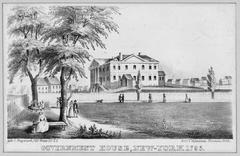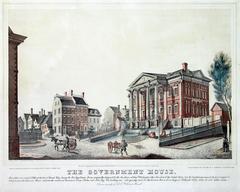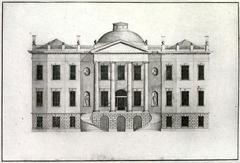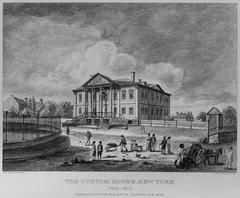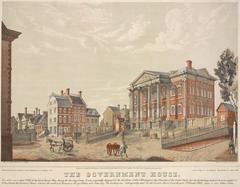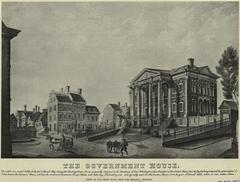
Government House New York City: Visiting Hours, Tickets, and Historical Sites Guide
Date: 14/06/2025
Introduction
Government House in New York City holds a distinctive place in the narrative of both the city and the nation. Constructed in the late 18th century as a neoclassical mansion facing Bowling Green, Government House was originally envisioned as the residence for President George Washington when New York was the nation’s first capital. Although never inhabited by the president and demolished in 1815, the site remains a touchstone for history enthusiasts. Today, the area—now home to the Alexander Hamilton U.S. Custom House and surrounded by iconic landmarks such as Bowling Green Park and Federal Hall—offers visitors the chance to connect with the city’s early political and architectural legacy.
This guide provides a comprehensive overview of Government House’s history, its architectural and cultural significance, practical visiting information, and recommendations for making the most of your trip to Lower Manhattan’s historic core (Metropolitan Museum of Art; NYC Parks; Wikipedia: Government House, New York).
Table of Contents
- Introduction
- Historical Overview: Conception, Construction, and Roles
- Demolition and the Evolution of the Site
- Visiting the Government House Site Today
- Architectural and Cultural Significance
- Legacy and Historical Memory
- Notable Figures and Events
- Practical Visitor Tips
- Frequently Asked Questions (FAQ)
- Conclusion
Historical Overview: Conception, Construction, and Roles
Government House was conceived in 1790–91, intended as a grand residence for the president amid the new nation’s quest for stability and prestige. Its neoclassical design—characterized by a stately two-story façade and imposing portico—reflected the aspirations of the early republic. The prime site at Bowling Green placed it at the center of governmental and commercial activity in lower Manhattan (Metropolitan Museum of Art).
However, by the time the mansion was completed, the federal capital had moved to Philadelphia. The building thus never served as a presidential residence but was repurposed as the official home for New York State governors, including George Clinton and John Jay, from 1791 to 1797. Later, it played a significant economic role as the city’s Custom House, managing tariffs and duties that helped establish New York as a leading port (Wikipedia: Government House, New York).
From 1807, Government House briefly housed the New-York Historical Society, emphasizing its status as a hub for cultural and intellectual life before its eventual demolition in 1815.
Demolition and the Evolution of the Site
Government House was demolished in 1815, as the city’s priorities and urban landscape shifted. The site underwent several transformations, eventually giving way to the construction of the Alexander Hamilton U.S. Custom House in the early 20th century (Wikipedia). Today, no physical remnants of Government House remain, but its memory is commemorated by a historical plaque installed by the Holland Society of New York in 1890, which is now displayed inside the Custom House.
Visiting the Government House Site Today
Location and Setting
The former site of Government House is at 1 Bowling Green, at the foot of Broadway in Lower Manhattan—a lively area surrounded by the Financial District, Battery Park, and numerous historic landmarks (Wikipedia: Government House (New York City)). The Alexander Hamilton U.S. Custom House now stands on this spot, serving as both a historical and architectural attraction.
Getting There and Accessibility
The area is highly accessible:
- Subway: 4/5 to Bowling Green, 1 to South Ferry, R/W to Whitehall Street.
- By Bus or Ferry: Direct access from the Staten Island Ferry terminal and several bus lines.
- Accessibility: The Custom House and surrounding public spaces are wheelchair accessible.
What to See
Alexander Hamilton U.S. Custom House
A masterpiece of Beaux-Arts architecture designed by Cass Gilbert, the Custom House is a National Historic Landmark. Inside, visitors will find:
- National Museum of the American Indian: Free admission; open Tuesday to Sunday, 10 AM to 5 PM (Smithsonian NMAI).
- Historic Plaques: Including the commemorative tablet installed by the Holland Society, detailing the site’s layered history.
- Rotunda and Murals: Grand murals by Reginald Marsh depicting New York Harbor’s commercial past.
Bowling Green Park
The city’s oldest public park, featuring historical markers and the famous Charging Bull sculpture. It’s a relaxing spot to enjoy the city’s vibrant atmosphere and learn about its colonial roots (NYC Parks: Bowling Green).
Nearby Attractions
- Federal Hall National Memorial: Site of George Washington’s inauguration; free admission, open daily.
- Battery Park: Offers ferry access to the Statue of Liberty and Ellis Island, plus Castle Clinton and sweeping harbor views.
- Stone Street Historic District: A cobblestone alley lined with restaurants and bars, reflecting Dutch colonial heritage.
Architectural and Cultural Significance
Government House set the tone for New York’s subsequent public buildings, with its neoclassical design symbolizing the ideals of democracy and civic virtue. Its influence is seen in the city’s later monumental architecture. The Custom House, which now occupies the site, continues this tradition with its grand Beaux-Arts style and serves as a living museum of both art and history (Metropolitan Museum of Art).
Legacy and Historical Memory
The Government House story is emblematic of New York City’s constant reinvention and adaptability. Its brief existence and the site’s subsequent transformations—from colonial fort to Custom House—mirror the city’s dynamic evolution. The commemorative marker and interpretive resources help keep its legacy alive, connecting visitors to the city’s early ambitions and revolutionary past (NYC Parks: Bowling Green History).
Notable Figures and Events
Prominent figures associated with Government House include George Washington (for whom it was built), Governors George Clinton and John Jay, and Alexander Hamilton, whose name now graces the Custom House on the original site. The building’s various roles as governor’s residence, Custom House, and historical society headquarters reflect its central place in the city’s political and cultural development (Wikipedia: Government House, New York).
Practical Visitor Tips
- Hours: The Custom House and National Museum of the American Indian are typically open 10:00 am – 5:00 pm (check Smithsonian NMAI for updates). Bowling Green Park is open daily from sunrise to sunset.
- Admission: Free for the museum and park; special exhibits may require advance registration.
- Best Times to Visit: Spring and early summer offer pleasant weather and frequent outdoor events (Loving New York).
- Guided Tours: Multiple walking tours of Lower Manhattan feature the Government House site. Book in advance for specialized historical tours.
- Facilities: The Custom House is wheelchair accessible, with restrooms, a gift shop, and information desks.
- Photography: Permitted inside the museum (no flash/tripods); the Custom House exterior and Bowling Green are popular photo spots.
Frequently Asked Questions (FAQ)
Q: Can I visit Government House today?
A: The original building was demolished in 1815. Its former site is now occupied by the Alexander Hamilton U.S. Custom House and is open to the public.
Q: Where was Government House located?
A: At 1 Bowling Green, at the southern tip of Manhattan, now the site of the Custom House.
Q: What is at the site now?
A: The Alexander Hamilton U.S. Custom House, home to the National Museum of the American Indian and historic plaques.
Q: Are tickets required to visit the site?
A: No tickets are needed for the museum or park, but special tours or exhibits may require advance booking.
Q: Is the site wheelchair accessible?
A: Yes, both the Custom House and surrounding public spaces are accessible.
Q: What are nearby historical sites worth visiting?
A: Federal Hall, Battery Park, Castle Clinton, Wall Street, and Stone Street Historic District.
Conclusion
Though Government House itself no longer stands, its legacy is deeply embedded in the historic landscape of Lower Manhattan. The site at Bowling Green—anchored by the Alexander Hamilton U.S. Custom House—offers a rich, multifaceted experience for visitors interested in the city’s political, architectural, and cultural evolution. By combining a visit to the Government House site with nearby attractions, guided walking tours, and museum resources, you can gain a deeper understanding of New York’s pivotal role in the nation’s history.
For more information, visit:
- Metropolitan Museum of Art’s collection entry on Government House
- Wikipedia: Government House, New York
- Smithsonian NMAI
- NYC Insider Guide
- VisitNYC.com
- New York Preservation Archive Project
Plan your visit today and discover the layers of New York City’s history! For more guides and audio tours, download the Audiala app and follow us on social media for updates.
References
- Government House New York: History, Legacy, and Visiting Historical Sites Near Bowling Green, 2025 (Metropolitan Museum of Art)
- Government House New York: History, Visitor Information, and Nearby Attractions, 2025 (Wikipedia: Government House, New York)
- Visiting the Government House Site and Alexander Hamilton U.S. Custom House in New York City: Hours, Tickets, and Nearby Historical Sites, 2025 (Wikipedia: Government House (New York City))
- Visiting Government House in New York City: History, Tickets, and Travel Tips, 2025 (New York Preservation Archive Project)
